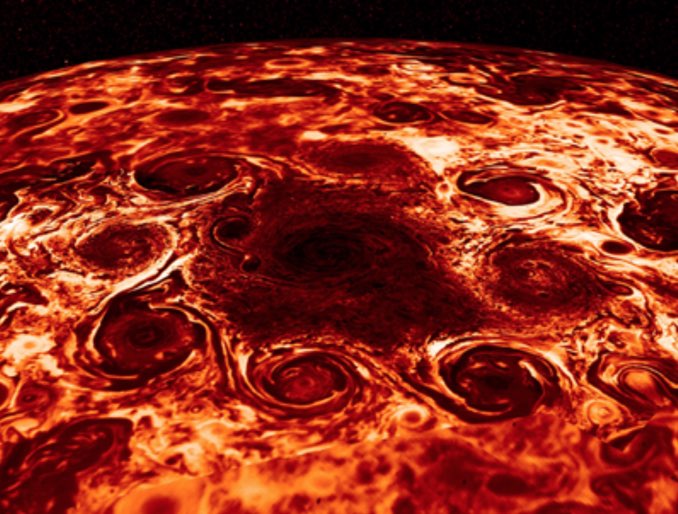Robert sent in this link – https://astronomynow.com/2018/03/07/new-juno-findings-amaze-scientists-s… … The spacecraft Juno has come up with data that have surprised scientists. Robert comments, both Jupiter and Saturn show a pattern of polygonal structures at their planetary poles. In his opinion, the Earth does too (a spreading system surrounding Antarctica). NASAs Juno spacecraft shows Jupiter's weath systems extend much deeper than previously believed and the huge planet rotates nearly as a rigid body below racing jet streams, storms, and cyclones. Jupiter's atmosphere (or weather layer) is 3000m in depth (1900 miles) and is about one per cent of Jupiter's mass. In contrast, Earth's atmosphere is less than one millionth of the mass. The fact that Jupiter has such a vast region rotating in opposite east and west bands is also a surprise. For example, images also 8 huge closely grouped cyclones up to 2900 miles across circling a central storm near the north pole with winds whirling at 220 mph …
 … at https://tallbloke.wordpress.com/2018/03/08/geometric-clusters-of-cyclone… … we have the same story but with more emphasis on the pattern of the cyclones – described as geometric clusters churning over Jupiter's poles. The shapes are fascinating. The octagonal shape contrasts somewhat with the 6 sided system spinning over Saturn's north pole – but what is going on? Jupiter also has air circling via east to west jet streams that penetrate thousands of miles below the visible cloud tops. Oldbrew comments – visible and infra red images from above each pole by the Juno spacecraft reveal a polygonal pattern of large cyclones (see www.nature.com/articles/nature25491 )
… at https://tallbloke.wordpress.com/2018/03/08/geometric-clusters-of-cyclone… … we have the same story but with more emphasis on the pattern of the cyclones – described as geometric clusters churning over Jupiter's poles. The shapes are fascinating. The octagonal shape contrasts somewhat with the 6 sided system spinning over Saturn's north pole – but what is going on? Jupiter also has air circling via east to west jet streams that penetrate thousands of miles below the visible cloud tops. Oldbrew comments – visible and infra red images from above each pole by the Juno spacecraft reveal a polygonal pattern of large cyclones (see www.nature.com/articles/nature25491 )
Meanwhile, and also at https://tallbloke.wordpress.com/2018/03/07/scientists-crack-70-year-old-… … which says that in 1942 Hannes Alfven of Sweden predicted the existence of a new type of wave due to magnetism acting upon plasma. Alfven waves are now an accepted reality. They also appear to maintain high temperatures on the Sun.
